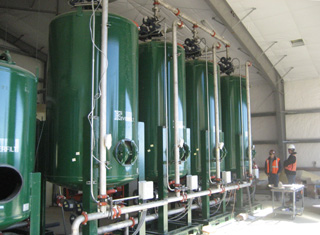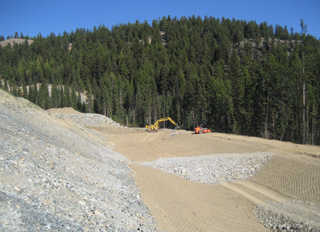
Surveys
DJC.COM
June 26, 2008
A green approach to gold mining in the Okanogan
Golder Associates

Banton
|
The Buckhorn Mountain Mine is the first new gold mine to be permitted in Washington state in more than 15 years and comes at a time of near record gold prices and renewed interest in mining in the United States. The underground mine is located at the 5,500-foot elevation on Buckhorn Mountain in Okanogan County, about 3.5 miles east of Chesaw and just a few miles south of the Canadian border.
Following an extensive environmental impact study, detailed engineering studies and permitting activities, owner Kinross Gold USA received in 2006 and 2007 water rights and water discharge permits for the mine. The mine is nearing final construction and officials plan to start processing gold ore by this fall.
Underground mining will take place for 7.5 years. According to the plan, up to 500 tons of ore and 1,500 tons of development rock will be mined every day during the life of the mine. Gold ore from the mine will be processed at an existing mill in Republic, part of Kinross’ Kettle River operations. The mill has processed ore from several satellite mines over the past 15-plus years, including the Key Mine, Lamefoot Mine, Kettle Mine, and most recently the K2 Mine.

Photos courtesy of Golder Associates An ion exchange water treatment plant will treat excess mine water before it is discharged into the environment. |
The Buckhorn area has a long history of mining ventures going back to the early 1900s. This includes underground mine workings accessed by the Roosevelt adit, the Magnetic Mine and the Gold Ax Mine. Kinross fully acquired the project in August 2006 from Crown Resources.
In the early 1990s, Battle Mountain Gold and Crown Resources proposed to mine the ore body at Buckhorn Mountain by open pit methods. After receiving the necessary permits, the project’s water rights were denied by the state Pollution Control Hearings Board because of concerns regarding the availability of water and impacts of the mine on local water resources.
The project sat idle in the late 1990s and was then reinitiated by Crown Resources in 2002 with an underground mining plan to address the water rights and water quality concerns.
Few visible effects

Gold ore will be removed from three portals at the Buckhorn Mountain Mine. |
Gold ore will be mined using three adits, or horizontal tunnels, at the Buckhorn Mountain Mine that will be advanced into the mountain and accessed by surface openings called portals. Personnel, equipment and rock will be transported in and out of the mine using the adits, which measure approximately 12 feet by 12 feet. To date, three portals have been constructed; the adits at two of the portals have been advanced 500 and more than 1,000 feet into the mountain.
During underground mining of the ore body, ore will be extracted from openings called stopes. After the ore is removed, the mine openings will be backfilled using structural fill (cemented sand and gravel) and development rock (non-ore rock). At the end of the mine life, there will be no development rock left on the ground surface, and the mine site will be reclaimed with little visible effects of the mining operation. This is much different from an open pit mine that leaves a large mine pit and covered rock stockpiles at the end of mining.
At mining projects, water is used to suppress dust (both on the surface and underground), to cool drilling equipment, and for general industrial purposes. Contact of water with rock during mining can result in increased concentrations of trace metals, sulfate and nitrogen compounds, and a change in pH. This water must be treated to meet applicable standards before it is discharged to surface water or groundwater.
Groundwater will flow into mines that extend below the water table (as is the case on Buckhorn Mountain). This water must also be collected and treated before discharge.
Lastly, mine dewatering has the potential to affect flow in surface streams, wetland areas and local wells. As a result of these issues, the Buckhorn Mountain Mine was engineered to both minimize overall water use requirements and to mitigate predicted impacts to the local water resources during operations and at closure.
Water management
To effectively address the water issues for the Buckhorn Mountain Mine, a water management plan was prepared by Golder Associates to ensure the proper use, treatment and discharge of water from the mine operations.

Part of the water management plan at Buckhorn includes an infiltration pond for treated mine water. |
The underground mining plan will use approximately 95 percent less water than the previously proposed Crown Jewel Mine. The plan identified the engineering measures that would be used to collect, divert, treat, and discharge surface water and stormwater on the site and groundwater inflow to the mine. Existing irrigation rights will be used to provide water for dust control.
Miners will use shotcrete to seal permeable fracture zones they encounter to minimize groundwater inflow to the mine. Groundwater that does flow into the mine will be collected in underground sumps and reused to minimize water use. Mine water that is not reused will be treated using a state-of-the-art ion exchange water treatment plant before discharge to surface water and groundwater under the site’s National Pollutant Discharge Elimination System permit. Reuse and discharge of mine water will ensure that there are minimal impacts to the hydrology of the Buckhorn Mountain area.
The underground water collection system will be supplemented by several dewatering wells that will provide a water supply for mining operations and also collect mine water that does not flow into the underground mine, thus protecting groundwater quality outside the mine area.
As part of the environmental studies, a three-dimensional groundwater flow model was developed to predict the effect of mining on groundwater levels and streamflow during mining and post-mining periods. Experts also evaluated the unique geological and hydrological setting of each spring, seep and wetland in the field, and then made an assessment regarding the effects of dewatering and appropriate mitigation.
The information from the groundwater modeling studies was used to develop extensive monitoring, mitigation and adaptive management plans for the hydrological and aquatic environments on Buckhorn Mountain.
The mitigation elements incorporated into the mine’s operating permits included:
• Non-use of several existing irrigation rights and a stock water right in the surrounding valleys to enhance streamflow.
• Wetland and stream augmentation using treated mine water and/or groundwater.
• Wetland and riparian habitat enhancement and preservation.
• Replacement of several blocking culverts on Forest Service lands to allow improved fish passage.
• Provision of wildlife watering facilities.
• Permanent set-aside of irrigated acreage following mine closure to provide long-term mitigation of the mine’s effects on water resources.
The Buckhorn Mine project has demonstrated that mining methods can be developed to reduce water use and to minimize impacts to sensitive environmental media. Continual environmental monitoring and adaptive management assessment is built into the project’s operating permits. This information will be used to determine the actual impact of the mine on the environment, and will be used to modify the mining process and mitigation measures, if necessary.
David Banton is a principal hydrogeologist employed Golder Associates since 1981. He has a bachelor’s degree in geography and geology from the University of Sheffield and a master’s degree in hydrogeology from the University of Birmingham.
Other Stories:
- Corporate social responsibility turns green
- Financing evolves to benefit the environment
- Homeowners rethink their waterfronts
- Will Earthships save the Earth?
- Municipalities discover the benefits of eco-roofs
- What lies ahead for sustainable design?
- Planning our communities for a low-carbon future
- City, tribe team up on clean water project
- Architectural firm sets a zero-energy goal
- New stormwater discharge challenges loom
- Green building’s future lies in innovation, conservation
- Seattle becomes a hotbed for clean technologies
- Speed up sustainable development with a planned-action EIS
- Avoiding fish-related construction delays
Copyright ©2009 Seattle Daily Journal and DJC.COM.
Comments? Questions? Contact us.